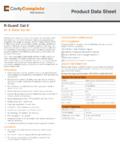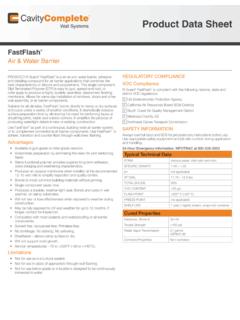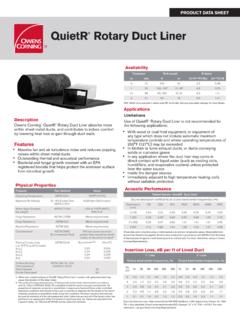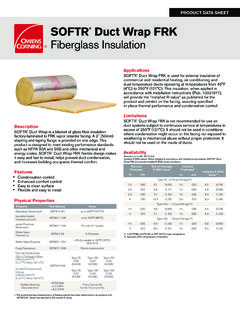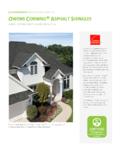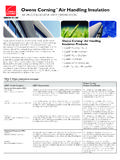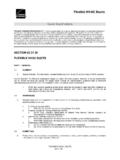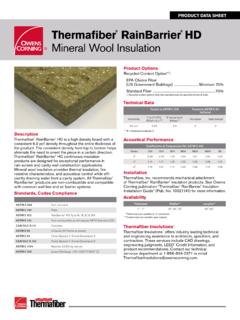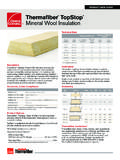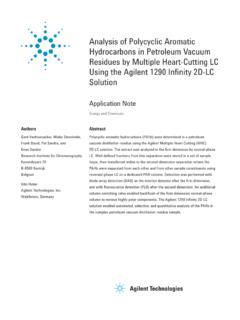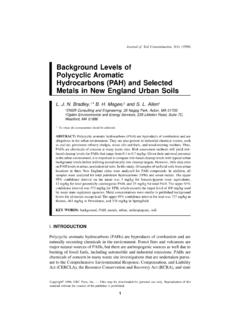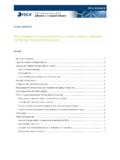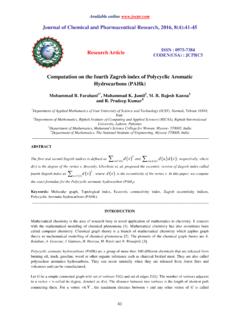Transcription of Polyaromatic Hydrocarbon Emissions from Asphalt …
1 Polyaromatic Hydrocarbon Emissionsfrom Asphalt Processing and Roofing ManufacturingOperationsSubmitted byAsphalt Roofing Manufacturers AssociationEnvironmental Task ForceSeptember I998 AbstractThe Clean Air Act of 1990 Section 112(c)(6) requires EPA to identify and regulate 90% of thesources of Polycyclic Organic Matter (POM). The Roofing Manufacturing and Asphalt Processingindustry segments of the Asphalt Roofing Industry have been identified in EPA s emissioninventory as sources of POM s.
2 EPA utilizes Polyaromatic Hyrdocarbons (PAH) as a surrogate forPOM s. EPA s estimate of PAH Emissions overstates the industry production and their emissionfactors are based on limited data. This resulted in significant overestimation of the industry PAHemissions. This paper presents revised emission estimates for these industry segments. Theindustry estimate suggests that the PAH Emissions for the Asphalt Roofing Industry are less then3% of those estimated by reduction of Emissions of Hazardous Air Pollutants (HAP) in the United States has beenmandated by Section 112 of the Clean Air Act, as amended in 1990.
3 This section of the Clean AirAct contains the original listing of 189 HAP s in Section 112-(b) (1). The Administrator of theEPA published the list of industry sources of Hazardous Air Pollutants pursuant to section 112(c) ofthe act and EPA is required to establish Maximum Achievable Control Technology (MACT)standards for the major Sources of HAPs in the identified industry segments. A major source isdefined as any facility source that has the potential to emit 10 tons per year of any individual HAPor 25 tons per year in the aggregate of all HAPs.
4 The Asphalt Roofing Industry was included inEPA s list of the industrial sources of HAPs(1)..The timing for the Asphalt Roofing Industry MACT standards is the year 2000.(2) The Asphalt Roofing Manufacturers Association (ARMA) iscurrently working with EPA in the development of these MACT addition to the above sections, Section 112(c)(6) of the Clean Air Act identifies sevenpollutants as being subject to special provisions for MACT standards.
5 EPA is required to list thesources of these pollutants and assure that sources accounting for at least 90% of the Emissions aresubject to standards under Section 112(d)(2) or Section 112(d)(4).Table 1 Section 112(c)(6) PollutantsAlkylated lead compoundsPolycyclic Organic MatterHexachlorobenzeneMercuryPolychlori nated Biphenyls2,3,7,8-tetrachlorodibenzfurans 2,3,7,8- Tetrachlorodibenzo-p-dioxinEPA prepared an emission inventory of section 112(c)(6) pollutants as required by the act.
6 Thisemission inventory was issued on June 11, 1997.(3) (3In the emission inventory, EPA used PAH as asurrogate for POM. The Asphalt Roofing Industry is included in this Emissions inventory as asource of PAH s. Inclusion in this listing opens the door for further regulation of industry s mandate to control 90% of the Emissions of Section 112(c)(6) sources allows EPA to includearea (non-major) sources of these pollutants in the MACT regulations for each industry.)
7 EPA hasrecently utilized the same emission inventory prepared for section 112(c)(6) as input to theirinventory of 40 pollutants subject to possible regulation under section 112(k). Section 112(k)requires EPA to regulate area sources to insure that at least 90% of the Emissions of 30 HAPS presenting health threats to urban population are ARMA Environmental Task force, faced with the possibility of MACT regulation on areasources of the Asphalt Roofing Industry, and the inconsistencies in the EPA estimates.
8 Utilizedrecent industry data to prepare a more accurate estimate of PAH 1990 Baseline Emission EstimateThe EPA 1990 Baseline Emission Estimate of 112(c)(6) Pollutants make several significantassumptions. EPA redefines the family of compounds to be regulated from Polycyclic OrganicMatter to Polynuclear Aromatic Hydrocarbons. PAH s are a narrower subset of the POM suggests the use of PAH 7 and PAH 16 groups as possible surrogates for total POM states that the species that make up the PAH 7 group are probable human carcinogens.
9 ThePAH 16group are those species measured by EPA Method 610. The members of the PAH7 andPAH 16groups are listed in the Table 7 GroupBenz(a)anthraceneBenzo(a)pyreneBenz o(b)fluorantheneBenzo(k)fluorantheneChry seneDibenz(a,h)anthraceneIndeno( 1,2,3-cd)pyreneTable 2 PAH 16 GroupAcenaphtheneAcenaphthyleneAnthracen eBenz(a)anthraceneBenzo(a)pyreneBenzo(b) fluorantheneBenzo(ghi)peryleneBenzo(k)fl uorantheneChryseneDibenz(a,h)anthraceneF luorantheneFluoreneIndeno(1,2,3-cd)pyren eNaphthalenePhenanthrenePyreneEPA s estimate of Asphalt Roofing Industry 1990 PAH Emissions was tons of PAH 7 peryear and tons of PAH 16 per estimates combined PAH Emissions for both Asphalt Processing and RoofingManufacturing segments The estimates are presented on page B-47 of the 1990 EmissionInventory of Section 112(c)(6)
10 Pollutants Final Report June 1997, Distributed by the EmissionFactor and Inventory Group (MD-14),, Emissions ,Monitoring and Analysis Division, Protection Agency, Research Triangle Park, North Carolina 27711. Due to severalerrors in input data, these EPA estimates are many times higher than the more detailed estimatesdescribed in the remainder of this paper. EPA does not document the source of their emissionfactors for both Asphalt Processing and Roofing Manufacturing.

